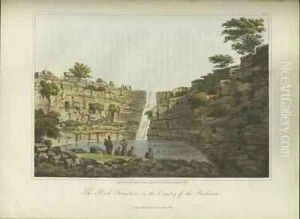Burchell, William John Paintings
William John Burchell was a pioneering British explorer, naturalist, traveler, artist, and author. He was born on July 23, 1781, in Fulham, London, England, into a family that was well-versed in botany. His father, William Burchell Sr., was a botanist and the owner of the Fulham Nursery, one of the most renowned plant nurseries of its day. This environment fostered in Burchell a deep interest in the natural world from a young age.
Burchell's travels began in earnest after he completed his education. In 1805, he embarked on a voyage to the East Indies, Saint Helena, and South America. However, it was his expedition to southern Africa, which lasted from 1810 to 1815, that cemented his reputation as a notable explorer and naturalist. During this time, he traveled over 7,000 miles within South Africa, collecting over 50,000 specimens and making numerous detailed drawings of the flora, fauna, and landscapes he encountered.
His work in South Africa provided valuable insights into the region's biodiversity and ecology. Burchell described many species new to science and amassed an impressive collection of specimens, including plants, insects, fish, reptiles, birds, and mammals. His meticulous records and sketches are still of scientific importance today.
After returning to England, he published the first volume of his acclaimed 'Travels in the Interior of Southern Africa' in 1822, with the second volume following in 1824. The books were well-received for their thoroughness and the quality of their illustrations. Despite his contributions to science and exploration, Burchell never achieved the level of fame and recognition that some of his contemporaries did.
Burchell's later years were marked by personal difficulties and a decline in his mental health. He became increasingly reclusive, eventually retiring to the Isle of Wight. He continued to work on his collections and writings but never published more of his extensive research. William John Burchell ended his own life on March 23, 1863, at the age of 81. Despite the tragic end to his life, his contributions to natural history and exploration have left an enduring legacy, as evidenced by the many species named in his honor.
